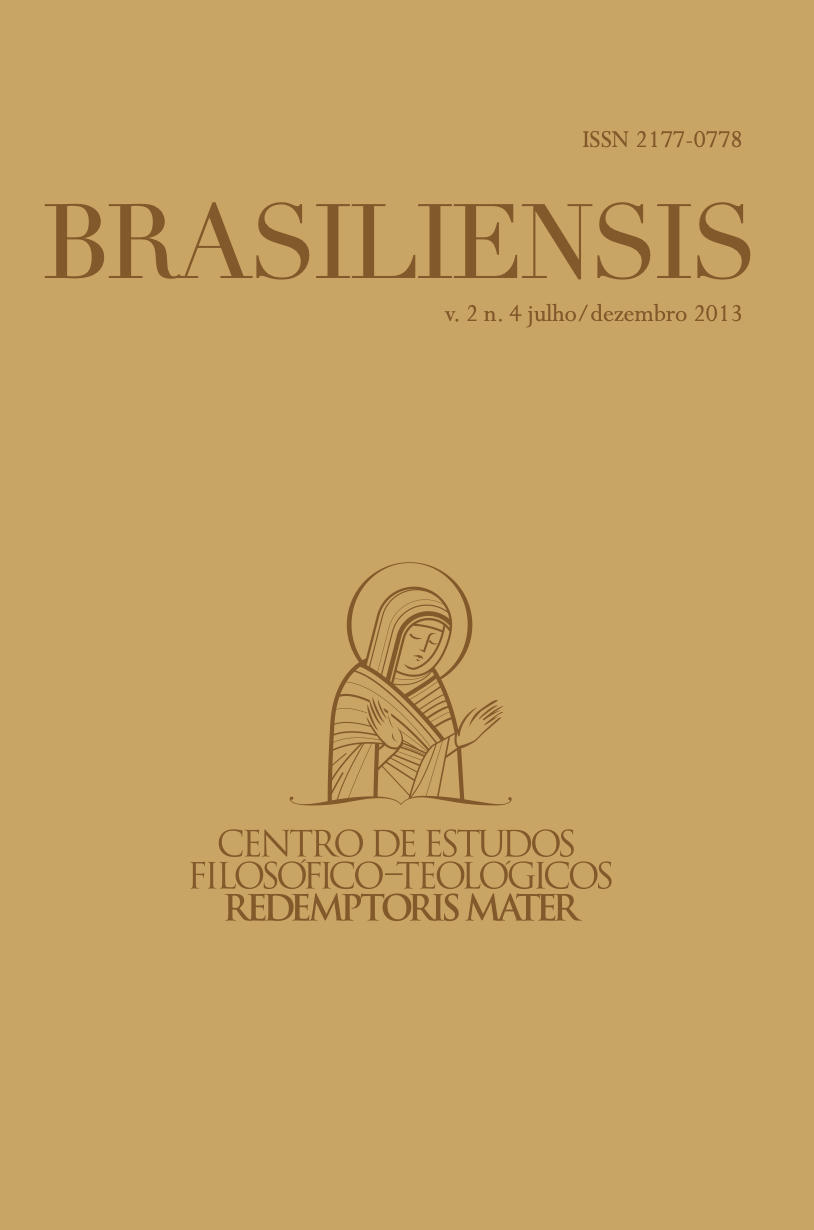A reflection on the question of the definition of the Church
Main Article Content
Abstract
Is it possible to elaborate an exact definition of the Church, which is able to accomplish its totality? It is verified that the ecclesiological argument lacks a proper differentiation between explicitly descriptive or conceptual notions and metaphorical use of abstractive procedures, that demonstrates the essential elements for a proper understanding of the Church. From a critique to the thought of J. Hamer, the author delineates a hypothesis with implications based on a proper terminology, so that the complex nature of the Church and its mysterious character incorporate the process of theological systematization in question. Thus it scroll through a trajectory that approaches the theme of knowability of the Church and its forms, as well the issue of its definability and its means - which illuminate aspects of the proposal for a renewed ecclesiology, whose thought is articulated around the notion of communion.
Article Details

This work is licensed under a Creative Commons Attribution-NonCommercial-NoDerivatives 4.0 International License.
The Creative Commons Attribution (CC BY) license is the most permissive Creative Commons license. It allows others to distribute, remix, adapt, and build upon your work, even for commercial purposes, as long as they give you credit for the original creation.
How to Cite
References
ADAM, K. Ekklesiologie im Werden. Kritische Bemerkungen zu D.-M.
Koster Kritik an den ekklesiologischen Versuchen der Gegenwart. TThQ 122, 1941.
ANTÓN, A. En Busca De Una Nueva Noción De Iglesia. In: ______.
El Misterio De La Iglesia, Evolución Historica De Las Ideas Eclesiologicas. 2. v. Madrid – Toledo: BAC, 1987.
______. Lo sviluppo della dottrina sulla Chiesa nella teologia dal Vaticano
I al Vaticano II. In: FACOLTÀ TEOLOGICA INTERREGIONALE MILANO. L’ecclesiologia dal Vaticano I al Vaticano II. Brescia: La Scuola, 1973,
BAÑEZ, D. Scholastica commentaria in secundam secundae angelici doctoris d.
Thomae. Venice, 1588.
BARRY, D. A plea for a more Comprehensive Definition of the Church.
IN: New-York Rev., Nova York, n. 2 , p. 691-697, mai 1907.
BENOIT, P. Corps, tête et plérome dans les épitres de la captivité. In: Exégèse
et théologie, v. 2, Paris: Cerf, 1961.
BOUYER, L. Newman. Sa Vie. Sa Spiritualité. Paris: Cerf, 1952.
______. Chronique d’histoire de la théologie contemporaine. Où en est la
théologie du Corps mystique ? Revue des Sciences Religieuses, n. 22, Estrasburgo, p. 313-333, 1948.
BRINKTRINE, J. Was ist die Kirche? Theologie und Glaube, n. 28, Paderbon,
p. 190-196, 1936.
BUSA, R. (Ed.). Thomae Aquinatis opera omnia. Milano, 1996. CD - ROM CARLINI, A.– CAPONE BRAGA, G.– PIERETTI, A. Idea. In: FONDAZIONE CENTRO STUDI FILOSOFICI DI GALLARATE (Ed.). Enciclopedia Filosofica. v. 6, p. 5425, Milão, 2006.
CASSIRER, E. Filosofia delle Forme Simboliche. Firenze: La Nuova Italia, 1964. CONCíLIO VATICANO II. Ad Gentes (Constituição Pastoral sobre a
atividade missionária da Igreja no mundo de hoje).
______. Gaudium et Spes (Constituição Pastoral sobre a Igreja no mundo de
hoje).
______. Lumen Gentium (Constituição dogmática sobre a Igreja).
______. Sacrosanctum Concilium (Constituição sobre a Sagrada Liturgia). CONGAR , Y. Le Saint-Esprit et le Corps apostolique, In: Esquisses du
Mystère de l ́Église. Paris: Cerf.
______. Position de l’Église, dualité et unité. In: ______. Saint Église. Paris:
Cerf, 1963.
______. Peut-on définir l’Église?. In: ______. Saint Église. Paris: Cerf, 1963,
p. 21-44.
COMISSÃO TEOLÓGICA INTERNACIONAL. Temi Scelti Di
Ecclesiologia. EV 1681, 1985.
DE VALENCIA, G. Commentariorum theologicum, 3. v. Ingoldstadt, 1603. DIANICH, S. Ecclesiologia, questioni di metodo e una proposta. Milano:
Pauline, 1993.
DOPP, J. – GATTEI, S. Definizione, In: FONDAZIONE CENTRO
STUDI FILOSOFICI DI GALLARATE (Ed.). Enciclopedia Filosofica. Milano: Bompiani, 2006, v. 2, p. 2597-2605.
DULLES, A. Models of the Church. Dublin: Gill & Macmilla, 1976. ELIADE, M. Immagini e Simboli. Saggi sul simbolismo magico-religioso.
Torino: Jaca Book, 2004.
FECKES, K. Das Mysterium der heiligen Kirche. Paderborn: F. Schöningh, 1934.
FENTON, J.C. Scholastic Definitions of the Catholic Church. American Ecclesiastical Review, n.111, 1944, Washington.
______. The Mystici Corporis and Definitions of the Church. American
Ecclesiastical Review, n.128, 1953, Washington, p. 450.
HAMER, J. Dix thèses sur l’Église comme communion, Nova et Vetera
Genève, n.59, 1984.
______. Ecclésiologie et sociologie, Nova et Vetera Genève, n.59, 1984. ______. L’Église est une communion, Nova et Vetera Genève, n.59, 1984. HOLBÖCK, F. Das Mysterium der Kirche in dogmatischer Sicht. In:
______. Mysterium Kirche In Der Sicht Der Theologischen Disziplinen, 1.v. Salzburg: Otto Müller, 1962.
JAKI, S. Les tendances nouvelles de l’ecclésiologie, Roma: Casa Editrice Herder, 1957. JOURNET, CH. L’église Du Verbe Incarné. 2. v. Paris: Desclée De Brouwer, 1951. KOSTER, M.D. Ekklesiologie im Werden, Paderborn: Bonifacius Druck, 1940. LUBAC, H. de. Méditation Sur L’église. Paris: Paris: AubierMontaigne,1953. MASSILLO, G. Popolo Dio: categoria teologica o metafora? RdT 36, 1995. MÜHLEN, E. Una mystica persona. Roma: Cità Nuova, 1968.
PASSAGLIA, C. De Ecclesia Christi commentariorum libri quinque. 2. v.
Regesburg: Ratisbonae, 1853-1856.
PENNA, R. Il mysterion paulino. Traiettoria e costituzione. Brescia: Paideia, 1978. PIÉ-NINOT, S., Eclesiología: La sacramentalidad de la comunidad cristiana,
Salamanca: Sígueme, 2007.
PILGRAM, F. Physiologie de L’Église. Paris – Bruxelles: Régis Ruffet et Cia, 1864. RAHNER, H. L’ecclesiologia dei Padri. Simboli della Chiesa. Milano: Città
Nuova, 1994.
RICOEUR, P. De l’interprétation. Essai sur Freud. Milano: Club del libro d’arte, 1965.
SANTINELLO, G., Nozione. In: CENTRO DI STUDI FILOSOFICI
DI GALLARATE. Enciclopedia Filosofica. Firenze, 1969, Vol. 4, p. 1072-173, Milão, 2006.
SCHMAUS, M. Dogmatica cattolica. 3. v. Torino: ElleDiCi, 1966. SEMERARO, M. Mistero, comunione, missisone. Bologna: EDB, 1996. SEMMELROTH, O. Ich Glaube die Kirche. Düsseldorf: Otto Patmos, 1959. STOLZ A. De Ecclesia. Freiburg: Herder, 1939.
Summa totius logicae, Pars I, c. XXVI. in: ROBINSON, R. Definition,
Oxford: Clarendon Press, 1972, p. 12-148.
TOMÁS DE AQUINO. De ente et essentia, 5 (ROLAND-GOSSELIN,
M.-D. (ed). Le “De Ente Et Essentia” De S. Thomas D’Aquin. Paris: Vrin, 1948).
TOSTATUS, A. Opera Omnia, V [In Matthaeum]. Cologne: J. Gymnicus. &
A. Hierat., 1613.
VETTER, J. Der heilige Augustinus und das Geheimnis des Leibes Christi.
Mainz: Matthias Gruenewald, 1929.
VITALI, D. Mater Ecclesia. Roma, 2008.
ZIRKER, H. Ecclesiologia. Brescia: Queriniana, 1987.

